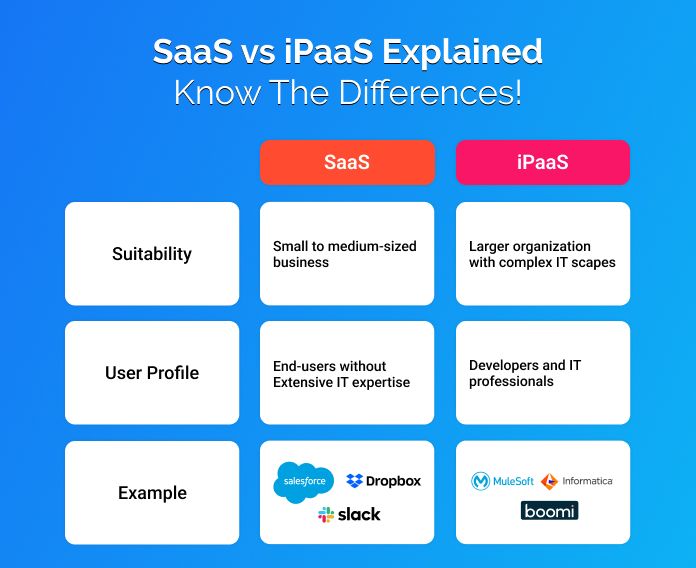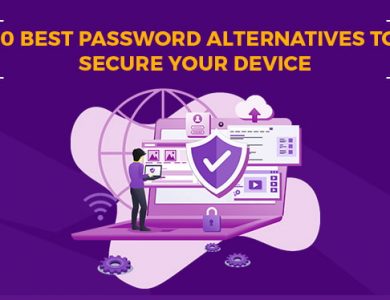SaaS vs. iPaaS Explained: Know The Differences!

In today’s fast-paced technology, bridging the gap between software and platform services has become increasingly crucial. This is where Integration Platform as a Service (iPaaS) and Software as a Service (SaaS) step in. With their rising popularity and adoption worldwide, understanding the differences and benefits of iPaaS and SaaS is essential for businesses of all sizes. In this article, we will delve into the fascinating world of iPaaS and SaaS, exploring their distinct characteristics, highlighting real-world examples, and ultimately helping you make informed decisions about which model best suits your needs. So, let’s embark on this journey of unraveling the wonders of iPaaS and SaaS.
What Is SaaS (Software as a Service)
SaaS, or Software as a Service, is a cloud-based software delivery model that enables users to access applications over the internet. With SaaS, the software is hosted on remote servers, maintained, and regularly updated by the service provider. This approach offers several benefits, including reduced upfront costs, scalability, flexibility, and easy accessibility.
By subscribing to SaaS, users can enjoy the convenience of accessing software as an on-demand service, eliminating the need for costly infrastructure investments. The pay-as-you-go subscription model makes SaaS a cost-effective solution for businesses of all sizes.
What Is iPaaS (Integration Platform as a Service)
iPaaS, or Integration Platform as a Service, is a collection of automated tools designed to integrate software applications deployed across various environments. iPaaS is commonly employed by large enterprises to seamlessly connect applications and data residing on-premises, public clouds, and private clouds.
iPaaS platforms offer pre-built connectors, business rules, and mapping capabilities that simplify application development and orchestrate integration flows. Some providers even offer custom development kits to modernize legacy applications, enhancing their compatibility with the integration ecosystem. iPaaS empowers businesses to streamline their operations by efficiently integrating diverse applications and data sources.
Best Examples of SaaS vs iPaaS
| Examples of SaaS vs iPaaS | |
| SaaS (Software as a Service) | iPaaS (Integration Platform as a Service) |
| Salesforce | Dell Boomi |
| Dropbox | MuleSoft Anypoint Platform |
| Slack | Informatica Cloud Integration |
| Zendesk | Jitterbit |
| HubSpot | SnapLogic |
| Microsoft 365 | IBM App Connect |
| Zoho | Zapier |
What is the difference between SaaS and iPaaS?

The main difference between SaaS (Software as a Service) and iPaaS (Integration Platform as a Service) lies in their focus and functionality within the realm of software as a service solution. SaaS provides users with direct access to cloud-based software applications, encompassing various categories such as CRM platforms, ERP systems, and document storage solutions. On the other hand, iPaaS serves as a middleware or platform specifically designed to integrate different applications, services, and even SaaS solutions. iPaaS acts as a connector and automation hub, facilitating the seamless flow of data and processes across disparate systems.
Video on SaaS and iPaaS Differences:
SaaS vs iPaaS Features Comparison Table
| SaaS (Software as a Service) | iPaaS (Integration Platform as a Service) |
| Cloud-based delivery model | Integration-centric platform |
| Pay-as-you-go subscription model | Automated tools for application integration |
| Hosted and maintained by service provider | Pre-built connectors for various applications |
| Accessible via web browsers and mobile apps | Business rules and mapping capabilities |
| Scalability and flexibility | Orchestration of integration flows |
| Simplified software deployment and updates | Modernization of legacy applications |
| Multi-tenancy architecture | Data mapping and transformation capabilities |
| User-friendly interface | Real-time data synchronization and replication |
| Centralized data storage | Monitoring and management of integration processes |
| Collaborative features | Support for hybrid cloud and multi-cloud environments |
| Customization options | Error handling and exception management |
| Automatic backups and data security | API management and governance |
| Regular software updates and patches | Support for event-driven architectures |
| Integration with third-party applications | Robust security measures and access controls |
Now, let’s delve deeper into each feature to understand the differences between these two service models.
1. Cloud-Based Delivery Model:
SaaS Users access software applications over the internet, eliminating the need for local installations.
IPaaS Provides a platform for integrating applications, services, and SaaS solutions, enabling seamless data exchange.
2. Pay-as-You-Go Subscription Model:
Using SaaS, users pay based on a subscription model, allowing cost-effective scalability and flexibility.
Whereas iPaaS offers pricing models based on the level of integration required, providing cost-efficiency for data integration needs.
3. Hosted and Maintained by Service Provider:
SaaS Service providers are responsible for hosting, maintaining, and updating the software, relieving users of infrastructure management.
IPaaS Focuses on providing tools and capabilities for data integration, mapping, and transformation rather than hosting software applications.
4. Direct Software Access:
SaaS Users can directly access the cloud-based software applications for their specific needs.
IPaaS acts as a middleware, enabling the connection and automation of different systems, including applications, services, and SaaS solutions.
5. Multi-Tenancy Architecture:
SaaS utilizes a multi-tenancy architecture where multiple users share the same instance of the software, benefiting from cost savings and automatic updates.
IPaaS focuses on integration capabilities rather than multi-tenancy, as its primary goal is to connect and orchestrate data flow between different applications and systems.
6. User-Friendly Interface:
SaaS emphasizes providing a user-friendly interface for direct interaction with the software, simplifying tasks and enhancing user experience.
iPaaS prioritizes providing a user-friendly interface for managing and orchestrating integration processes, offering visual tools and dashboards for monitoring and managing data flows.
7. Customization Options:
SaaS offers customization options within the software to cater to specific business needs, allowing users to configure settings, workflows, and preferences.
iPaaS focuses on customization options related to data integration, providing tools to map, transform, and manipulate data between different systems and applications.
8. Integration with Third-Party Applications:
SaaS may offer integration capabilities with select third-party applications, allowing seamless data exchange and interoperability.
iPaaS specializes in integrating various third-party applications and systems, providing pre-built connectors and APIs to facilitate data flow across different platforms.
9. Automatic Backups and Data Security:
SaaS includes automatic backups and robust security data security measures to protect user data and ensure business continuity.
iPaaS concentrates on data security and compliance within the context of integrating systems, providing encryption, access controls, and monitoring mechanisms to ensure secure data exchange.
Also Read: Best AI Cloud Platforms
How do SaaS and iPaaS Implementations Look in Practice?
Businesses leverage both SaaS and iPaaS solutions to optimize their operations. SaaS applications like Salesforce are used as standalone software solutions, accessed through web browsers. To enhance efficiency and streamline workflows, businesses can utilize iPaaS platforms like Zapier. iPaaS connects different SaaS applications, enabling seamless data integration and workflow automation.
For example, a business can integrate Salesforce as a SaaS CRM solution with other applications like Shopify or QuickBooks using an iPaaS platform, automating data synchronization and improving overall operational efficiency.
Benefits of iPaaS Integration with SaaS
iPaaS integration with SaaS brings numerous benefits. It enables seamless data integration, ensuring smooth and accurate synchronization across applications. Workflow automation streamlines processes, boosting productivity and efficiency.
With centralized access to data from multiple applications, employees can work more collaboratively and make informed decisions. iPaaS scalability accommodates business growth, while cost savings come from simplified integration processes and reduced manual effort.
Overall, iPaaS integration enhances operational efficiency, optimizes workflows, and empowers businesses to leverage the full potential of their SaaS applications.
Challenges of Integrating SaaS with iPaaS platforms
Integrating SaaS with iPaaS platforms poses challenges. Compatibility is complex due to varying data formats, APIs, and protocols. Managing multiple SaaS applications and intricate data flows requires careful planning and transformation. Security concerns arise when sharing data across systems, necessitating robust protection measures. Scalability becomes crucial as businesses grow, requiring the iPaaS platform to handle increased data volume. Ongoing monitoring, maintenance, and issue resolution are essential. Overcoming these challenges demands close collaboration between SaaS and iPaaS providers to address compatibility, complexity, security, scalability, and monitoring effectively. By tackling these challenges, businesses can achieve successful integration, streamline operations, and maximize the benefits of both SaaS and iPaaS solutions.
Do SaaS Companies Need Both Embedded iPaaS and Standalone iPaaS?
SaaS companies can greatly benefit from both embedded iPaaS and standalone iPaaS solutions. Embedded iPaaS enhances the user experience by offering seamless data exchange within the SaaS platform, simplifying integration for customers. It adds value to the product and improves customer satisfaction.
On the other hand, standalone iPaaS provides the SaaS company with a robust integration platform, enabling automation of workflows, integration with multiple systems, and scalability. It caters to the internal integration needs of the company, streamlining operations and enhancing efficiency.
By leveraging both embedded and standalone iPaaS, SaaS companies can deliver a comprehensive integration solution to their customers while effectively managing their internal integration requirements.
FAQs about SaaS and iPaaS
1. Can SaaS and iPaaS be used together?
Yes, SaaS and iPaaS can be used together as iPaaS provides the integration capabilities to connect SaaS applications with other systems.
2. Which one is more suitable for small businesses?
SaaS is often more suitable for small businesses as it provides access to ready-to-use software applications without the need for extensive integration requirements.
3. Do SaaS and iPaaS require extensive IT infrastructure?
No, both SaaS and iPaaS models eliminate the need for extensive IT infrastructure as the software and integration platform are hosted and maintained by service providers.
4. Can SaaS and iPaaS be accessed remotely?
Yes, both SaaS and iPaaS can be accessed remotely over the internet, providing convenience and flexibility for users.
5. Which is Cheaper iPaaS or SaaS?
iPaaS and SaaS costs vary based on platform, solution scope, and usage factors. It’s difficult to directly compare, as they serve different purposes. Assess providers to determine cost-effectiveness for your needs.



